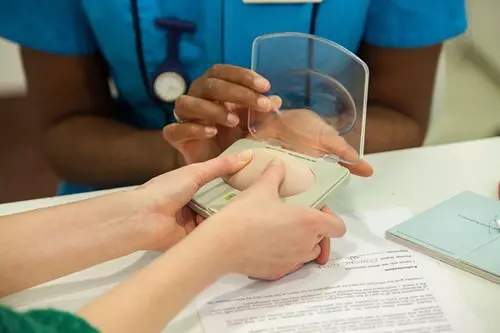The contraceptive implant is one or two small plastic rods which are about 4cm long and sit just under the skin on the inside of your upper arm. The implant prevents pregnancy for three to five years (depending on the type).
In this blog, you will find information about:
- What the contraceptive implant is
- The effectiveness of the implant
- Advantages, disadvantages and side effects of the implant
- Risks associated with the implant
- The fitting and removal of the implant
- Where you can have the implant fitted and removed
What is the contraceptive implant?
The contraceptive implant is one or two small plastic rods which are about 4cm long and sit just under the skin on the inside of your upper arm. Depending on the type of implant that is used, this contraceptive method will prevent against pregnancy for three to five years.
The implant works by slowly releasing a hormone called progestogen in your blood. The hormone stops the body releasing an egg each month. The hormone also makes it harder for sperm to get into the uterus (womb).
Inserting the implant is a simple procedure that takes about five minutes. A trained person inserts the implant under the skin on the inside of your upper arm. Your arm is numbed before insertion, so it is generally not painful. Once inserted the implant does not move around your body, although it may occasionally move slightly from the incision sight. This should not affect the efficacy of the implant, and implant removal should still be easy.
You can feel the contraceptive implant under the skin.
In the image below, you can see a dummy implant used in clinics to show the client what the implant will feel like in their arm.

In the first few days after insertion, keep the section of your arm where the implant was inserted clean and dry if you can. You can wrap your arm in cling-film when you have a shower. You can remove the bandage after a few hours and remove the dressing after 2 – 3 days. You will have a small puncture mark where the implant was inserted into your arm, but it should not be painful.
Effectiveness of the contraceptive implant
The implant works very well at preventing pregnancy and is one of the most effective contraceptive methods available. The implant is more than 99% effective with perfect use.
Fewer than 1 in 100 people using the implant will get pregnant in a year.
If the implant is fitted during the first five days of your menstrual cycle, you’ll be immediately protected against becoming pregnant. If it’s fitted on any other day of your menstrual cycle, you’ll need to use additional contraception (such as condoms) for seven days.
Advantages of the contraceptive implant
One of the main advantages of using the contraceptive implant is that once in place, you don’t need to think about the implant or do anything until it needs replacing. This can be up to either three or five years after your implant is fitted, depending on the type of implant that is being used. If you would prefer not to need to remember contraception each day, this may be the perfect method for you.
Other advantages of the contraceptive implant include:
- You can get the implant removed whenever you want
- Your fertility will return to normal immediately after the implant is removed
- You can have an implant inserted right after childbirth, abortion or miscarriage
- You can continue to use the implant when breastfeeding
- It is not used during sex so will not affect spontaneity
Contraceptive implant disadvantages and side effects
As with all methods of contraception, there are a number of possible side effects which may occur when using the contraceptive implant. Most of these side effects will settle down with time, however you can choose to have your implant removed at any time.
Most users of the implant will have a change in their bleeding patterns. The amount of bleeding usually the same or less than usual but can be irregular or stop altogether. For some, constant bleeding may occur. Whilst these changes in bleeding are not harmful to your health, it may be worth considering implant removal if you are unhappy with these changes or seeking advice from a medical professional. Once the implant has been removed, your bleeding should return to normal.
A small number of users may experience other side effects when using the implant, such as acne, headaches, mood changes, breast tenderness or weight gain. These symptoms usually resolve within the first few months of starting to use the implant.
The use of some medications, such as those for seizures (fits), HIV or for tuberculosis, can make the implant less effective. It is important to check with your medical provider if your medications are compatible with the implant when evaluating whether this method is right for you.
You may also notice a bruise, tenderness or swelling around the implant. These side effects should disappear after a couple of weeks.
Risks associated with the implant
- The implant sits just under the skin. There may be a very small scar where the implant is inserted and removed but it will not be obvious to others that you have an implant.
- There is a very small risk of infection at the site of fitting.
- Very rarely an implant can be inserted too deeply, which could cause damage to blood vessels or nerves.
- Very rarely, the implant may move, if you cannot feel it seek medical advice.
- Condoms are the only contraceptive method which protect against sexually transmitted infections. To ensure protection from both pregnancy and infection, we recommend “dual protection”. This means using a male or female condom in addition to the contraceptive method of your choice to prevent pregnancy.
Contraceptive implant fitting and removal
Having the implant fitted by a trained healthcare professional involves a simple procedure that usually lasts around five minutes. Your arm is numbed before insertion, so the fitting should not hurt.
Whilst there are many advantages to using the implant, we know that when it comes to deciding on which contraception to use, it’s not a one-size-fits-all approach. If you decide that the implant isn’t the right method for you having had it fitted – or are struggling with ongoing side effects – implant removal is quick and easy. You can have your implant removed at any time. Implant removal side effects may include slight bruising or pain at the site of removal. A local anaesthetic can often be used to reduce pain and discomfort. Once the implant has been removed, you should keep the area clean, dry and covered.
In the UK, you can make an appointment to have the implant fitted or removed – and to access other LARC (Long-Acting Reversible Contraception) services, such as coil fitting and removal – at sexual health clinics, contraception clinics and some GP surgeries.
Contraception counselling is always offered as part of abortion care, but we also offer contraception services in some parts of England for people who have not accessed our abortion services.
Aside from these clinics, MSI UK can only offer you contraception counselling as part of your abortion treatment. If you would like to access contraception counselling but are not having abortion treatment with MSI UK, ask your GP or local sexual health clinic about services near you.
“CHOICE”: MSI UK’s digital contraception counsellor
At MSI UK, we believe that information about contraception should be readily available. If you need help finding the best contraceptive method for you, try our digital contraception counsellor “Choice”. Using “Choice”, you can receive personalised contraceptive advice by answering a few short questions about your lifestyle, preferences, needs and medical history.
Useful links:
For more information on the contraceptive implant, read more on the NHS website: ‘Contraceptive Implant: Your Contraception Guide’
Find out more about our Contraception Services










































